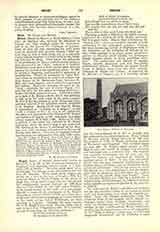

Brieuc (BRIOCUS, BRIOC, or BRU), Saint, a Celtic saint of Brittany who received his education in Ireland and then studied under St. Germanus, said to be the famous St. Germanus of Auxerre. Much of what we read concerning his early years must be received with caution; indeed, Ussher asserts that he was of Irish birth, but it is tolerably certain that he returned to France early in 431, bringing with him St. Iltud. Even before his ordination to the priesthood, St. Brieuc worked several miracles, duly chronicled in his “Acts” (edited by F. Godefrid Herschenn), and after a short period spent with his parents, he entered on his missionary career. In 480, he settled in Armorica, and founded a monastery at Landebaeron. Thence he proceeded to Upper Brittany where he established an oratory at a place ever since known as St. Brieuc-des-Vaux, between St. Maio and Land Triguier, and of which he was named first bishop. Numerous miracles are cited in the “Acts”, especially his cure of Count Riguel, who gave the saint his own palace of Champ-du-Rouvre, as also the whole manorial estates. Authorities differ as to date of St. Brieuc’s death, but it was probably in 502, or in the early years of the sixth century. He died in his own monastery at St. Brieuc-des-Vaux, and was interred in his cathedral church, dedicated to St. Stephen. Baring-Gould says that St. Brieuc is represented as “treading on a dragon”, or else “with a column of fire” as seen at his ordination. His relics were translated to the Church of SS. Sergius and Bacchus of Angers, in 865, and again, in a more solemn manner, on 31 July, 1166. However, in 1210, a portion of the relics was restored to St. Brieuc Cathedral, where the saint’s ring is also preserved. The festival of St. Brieuc is celebrated on 1st May, but, since 1804, the feast is transferred to the second Sunday after Easter. Churches in England, Ireland, and Scotland are dedicated to this early Celtic saint.
W. H. GRATTAN FLOOD

